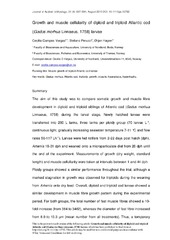Growth and muscle cellularity of diploid and triploid Atlantic cod (Gadus morhua Linnaeus, 1758) larvae
Permanent lenke
https://hdl.handle.net/10037/8714Dato
2015-05-26Type
Journal articleTidsskriftartikkel
Peer reviewed
Sammendrag
The aim of this study was to compare somatic growth and muscle fibre development in diploid and triploid siblings of Atlantic cod (Gadus morhua Linnaeus, 1758) during the larval stage. Newly hatched larvae were transferred into 200-L tanks, three tanks per ploidy group (70 larvae L−1, continuous light, gradually increasing seawater temperature 7–11°C and flow rates 50–117 L h−1). Larvae were fed rotifers from 2 to 22 days post hatch (dph), Artemia 19–31 dph and weaned onto a microparticulate diet from 26 dph until the end of the experiment. Measurements of growth (dry weight, standard length) and muscle cellullarity were taken at intervals between 1 and 44 dph. Ploidy groups showed a similar performance throughout the trial, although a marked stagnation in growth was observed for triploids during the weaning from Artemia onto dry feed. Overall, diploid and triploid cod larvae showed a similar development in muscle fibre growth pattern during the experimental period. For both groups, the total number of fast muscle fibres showed a 10-fold increase (from 384 to 3462), whereas the diameter of fast fibre increased from 8.9 to 13.3 μm (mean number from all treatments). Thus, a temporary but significant effect of triploidy on fast muscle fibre growth pattern was observed in 19 dph larvae in terms of fibre size and number, with triploids showing larger mean fast fibre diameter (11.62 ± 0.63 vs. 10.05 ± 0.34) and a lower number of fibres with a diameter <5 μm than their diploid siblings. Thus, this was found to be related to larvae size and to the differences in total fast fibre cross sectional areas rather than to ploidy status. Overall, our results suggest possible deficiencies in nutrients’ digestion and absorption of triploid cod larvae particularly during the transitional period from live food to inert diets.
Beskrivelse
Accepted manuscript version. Published version at http://doi.org/10.1111/jai.12792.


 English
English norsk
norsk